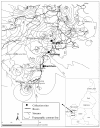Bionomics of Anopheline species and malaria transmission dynamics along an altitudinal transect in Western Cameroon
- PMID: 20482824
- PMCID: PMC2889998
- DOI: 10.1186/1471-2334-10-119
Bionomics of Anopheline species and malaria transmission dynamics along an altitudinal transect in Western Cameroon
Abstract
Background: Highland areas of Africa are mostly malaria hypoendemic, due to climate which is not appropriate for anophelines development and their reproductive fitness. In view of designing a malaria control strategy in Western Cameroon highlands, baseline data on anopheline species bionomics were collected.
Methods: Longitudinal entomological surveys were conducted in three localities at different altitudinal levels. Mosquitoes were captured when landing on human volunteers and by pyrethrum spray catches. Sampled Anopheles were tested for the presence of Plasmodium circumsporozoite proteins and their blood meal origin with ELISA. Entomological parameters of malaria epidemiology were assessed using Mac Donald's formula.
Results: Anopheline species diversity and density decreased globally from lowland to highland. The most aggressive species along the altitudinal transect was Anopheles gambiae s.s. of S molecular form, followed in the lowland and on the plateau by An. funestus, but uphill by An. hancocki. An. gambiae and An. ziemanni exhibited similar seasonal biting patterns at the different levels, whereas different features were observed for An. funestus. Only indoor resting species could be captured uphill; it is therefore likely that endophilic behaviour is necessary for anophelines to climb above a certain threshold. Of the ten species collected along the transect, only An. gambiae and An. funestus were responsible for malaria transmission, with entomological inoculation rates (EIR) of 90.5, 62.8 and zero infective bites/human/year in the lowland, on the plateau and uphill respectively. The duration of gonotrophic cycle was consistently one day shorter for An. gambiae as compared to An. funestus at equal altitude. Altitudinal climate variations had no effect on the survivorship and the subsequent life expectancy of the adult stage of these malaria vectors, but most probably on aquatic stages. On the contrary increasing altitude significantly extended the duration of gonotrophic cycle and reduced: the EIR, their preference to human blood and consequently the malaria stability index.
Conclusion: Malaria epidemiological rooting in the outskirts of Western Cameroon highlands evolves with increasing altitude, gradually from stable to unstable settings. This suggests a potential risk of malaria epidemic in highlands, and the need for a continuous epidemiological surveillance.
Figures



References
-
- Clements AN. The biology of Mosquitoes: development, nutrition and reproduction. 2. Vol. 1. CABI Publishing, London School Hyg. Trop. Med.; 2000.
-
- Beier JC, Oster CN, Onyango FK, Bales JD, Sherwood JA, Perkins PV, Chumo DK, Koech DV, Whitmire RE, Roberts CR. Plasmodium falciparum incidence relative to entomologic inoculation rates at a site proposed for testing malaria vaccines in western Kenya. Am J Trop Med Hyg. 1994;50:529–536. - PubMed
-
- Snow RW, Omumbo JA, Lowe B, Molyneux CS, Obiero JO, Palmer A, Weber MW, Pinder M, Nahlen B, Obonyo C, Newbold C, Gupta S, Marsh K. Relation between severe malaria morbidity in children and level of Plasmodium falciparum transmission in Africa. Lancet. 1997;349:1650–1654. doi: 10.1016/S0140-6736(97)02038-2. - DOI - PubMed
-
- Jetten TH, Martens WJM, Takken W. Model simulation to estimate malaria risk under climate change. J Med Entomol. 1996;33:361–371. - PubMed
Publication types
MeSH terms
Substances
LinkOut - more resources
Full Text Sources
Medical

